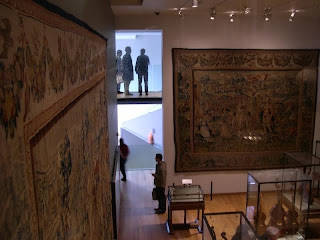
Recently, I set up a book club at work with the help of some colleagues, one of whom you may know as
Book Snob. It is very democratic as we all put book suggestions into the hat and we all bring cakes to share around - cake is essential for fuelling literary discussion. Last Wednesdays' choice was
Being Dead by John Crace which, although a short book, sparked a lot of lively discussion and I came away with lots of new ideas to think about.
Being Dead is a lyrically written examination of death. The two middle-aged protagonists are murdered in the sand dunes where they first had sex together. They are both scientists, complex characters and die in a horrific way - together. It is this togetherness that is the guiding light within, what would otherwise be, quite a depressing read.
Although, would this be depressing if it weren't for the fact that we are not at peace with death? We cannot handle our own mortality and we tend to move away from confronting our fragility - essentially we are all on our way to the end of our lives. We are powerless over our own deaths as Crace starkly shows us. Crace also highlights the arbitrary nature of death - we never know when our last day will be or how we will die and his character Celice was killed mid-sentence, in full flow and in her prime.
Joseph and Celice are an ordinary married couple going about their lives. Celice is bored and disappointed and she is still trying to find her way through life. Joseph is quiet, a bit odd and loves his wife. He wakes up on his last day with an overwhelming desire to go back to where they first met and romantically rekindle their sexual spark in the location of their first passionate encounter. It is this amalgamation of their ordinariness and their going on a special trip that makes their death, and the manner of their death, more stark as they are cut down in the midst of a sacred and fragile act.
The fragility of their love-making is transposed onto the fragility of their very being - in minutes they are both dead and nature, science and ultimately fact, start to take over, but perhaps it is not as depressing as it may seem. Joseph and Celice are united in death:
Joseph's grasp on Celice's leg had weakened as he'd died. But still his hand was touching her, the grainy pastels of her skin, one fingertip among her baby ankle hairs. Their bodies had expired, but anyone could tell - just look at them - that Joseph and Celice were still devoted. For while his hand was touching her, curved round her shin, the couple seemed to have achieved that peace the world denies, a period of grace, defying even murder.
It is the 'period of grace' which is presented to the reader throughout the novel. Their bodies are not sanitised by our rituals of death such as cleaning, make-up and disinfectant. Instead, Joseph and Celice are allowed, for a time, to blend with nature - to become part of the natural processes of life and death.
The book is at times an uncomfortable read, Crace goes into the detail of decomposing bodies at great length (maybe I just have a weak stomach) but the novel has stayed with me and made me consider my own mortality and how I think about death.
I would never have chosen to read this book had it not been for the V&A Book Club; which is entirely the purpose of a book club - to encourage us to pick up books we wouldn't have done ordinarily. I try to keep my reading horizons broad but, I admit, I do read a lot of early twentieth century literature so the book club has led me down a new reading path and I am looking forward to our meeting next month.







